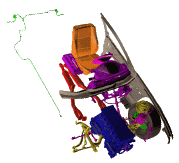
Institut für Informatik
Lehr- und Forschungseinheit für Datenbanksysteme
Institute for Computer Science
Database and Information Systems
 |
Ludwig-Maximilians-Universität München Institut für Informatik Lehr- und Forschungseinheit für Datenbanksysteme |
University of Munich Institute for Computer Science Database and Information Systems |
| [ Objective | Techniques | Applications | Work In Progress | Team | Gurus | Partners | Publications | Student Work ] |
 |

The development, design, manufacturing and maintenance of modern engineering products is a very expensive and complex task. Today, thousands to millions of CAD files of a car or an airplane may occupy terabytes of distributed secondary and tertiary storage. The main objective of this project is to find techniques to manage effectively and efficiently huge enterprise-wide amounts of spatial data and to evaluate them in industrial settings. As main application we focus on collision detection and within-distance queries for digital mockup and on similarity search in large CAD databases.
Representation and approximation of three-dimensional surfaces and solids
Typically, a very high accuracy is required for spatial CAD data when used in a modern manufacturing environment. In this project, we develop and evaluate algorithms to approximate spatial CAD data by sets of geometric primitives. These representations can be used as spatial keys in a database of high resolution CAD models.Multi-tiered spatial query processing
When storing conservative approximations of the CAD models in the database, we are able to process spatial queries like collision queries or within-distance queries in a multi-tiered fashion. An efficient and complete filtering mechanism determines only a small percentage of the CAD parts to be downloaded into main memory for exact geometric calculations.Spatial access methods for object-relational database systems
Spatial access methods are employed to index CAD data on secondary storage. They support the multi-tiered query process and therefore are the main component to speed-up spatial queries for digital mockup and similarity search. In this project, we develop access methods which can be easily implemented and integrated into off-the-shelf object-relational database systems.Spatial databases and engineering data management
Spatial CAD databases along with their spatial query processor have to be linked to engineering data management (EDM) tools to ensure enterprise-wide availability and consistent usage of CAD data. This is achieved by providing standard interfaces for the spatial data management as SQL for update operations and spatial queries or common file formats for the exchange of spatial data.
Collision detection and within-distance queries for digital mockup
Tools for digital mockup require easy and efficient access to all CAD files of a specific product instance or product family. For collision detection and within-distance queries, our database approach replaces time-consuming batch runs on the whole database with an efficient filter carefully picking only the relevant parts for download into main memory.Spatial similarity search
The major goal of similarity search is to reduce the cost of developing and producing new parts by maximizing the reuse of existing parts. We have developed the prototype system S3 to evaluate techniques for the management and retrieval of two-dimensional CAD geometries. Future plans include the extension of these techniques for three-dimensional applications.
Dynamische Anfragebearbeitung für interaktive Systeme
Räumliche Indexstrukturen ermöglichen eine effiziente Verwaltung von Millionen von Objekten einer sehr großen virtuellen Umgebung. Die Darstellung oder Weiterverarbeitung eines Ausschnitts dieser virtuellen Umgebung, z.B. für visuelles oder haptisches Rendering, kann mit Hilfe der räumlichen Indexstrukturen effizient unterstützt werden. Im Gegensatz zu statischen Bereichsanfragen von CAD-Bauteilen benötigen derartige Anwendungen Sequenzen von räumlichen Anfragen. Diese Anfragen haben typischerweise einen räumlichen Bezug zueinander und können mit Hilfe der dynamischen Anfragebearbeitung effizient unterstützt werden. Das Ziel der dynamischen Anfragebearbeitung ist die Unterstützung von Echtzeit-Simulationen zur Exploration großer virtueller Umgebungen mit Hilfe von geometrische CAD-Datenbanken.Using Data Compressors for Efficient Query Processing
The conservative approximation of spatial objects by a set of voxels results in high storage requirements. This leads to long query times, especially for high resolutions. Using data compression is a smart way to lower the resulting high I/O costs. Special care is taken to find a good compromise between I/O- and CPU costs. In addition, we analyze which degree of redundancy is most suitable for high resolution voxelized spatial objects.Spatial Similarity Search in 3D Data
We are developing an industrial prototype, called BOSS (Browsing OPTICS-Plots for Similarity Search). BOSS is based on the approach to evaluate similarity models using the hierarchical clustering algorithm OPTICS. BOSS is an interactive data browsing tool which depicts the reachability plot computed by OPTICS in a user friendly way together with appropriate representatives of the clusters. This intuitive illustration supports the user in his time-consuming task to find similar parts in large databases containing 3D CAD objects.
Bei Problemen oder Vorschlägen wenden Sie sich bitte an:
wwwmaster@dbs.informatik.uni-muenchen.de
Last Modified: